The Right to be Environmentally Conscious
Here at Foreword Reviews, we are lucky to call the beautiful town of Traverse City, Michigan, home. In this small city on a Lake Michigan bay, we’re surrounded by expansive forests, golden beaches, rolling dunes, and shimmering lakes; any native of this wonderful place has a strong instinct to appreciate and protect the nature around us. Unfortunately, not everyone shares our same compassion for the Earth—but we want to help change that. Here are some books full of tales inspiring, heartbreaking, and educational that serve to remind us all of the great beauty that encompasses us, as well as the great danger it faces.
A North Country Almanac
Reflections of an Old-School Conservationist in a Modern World
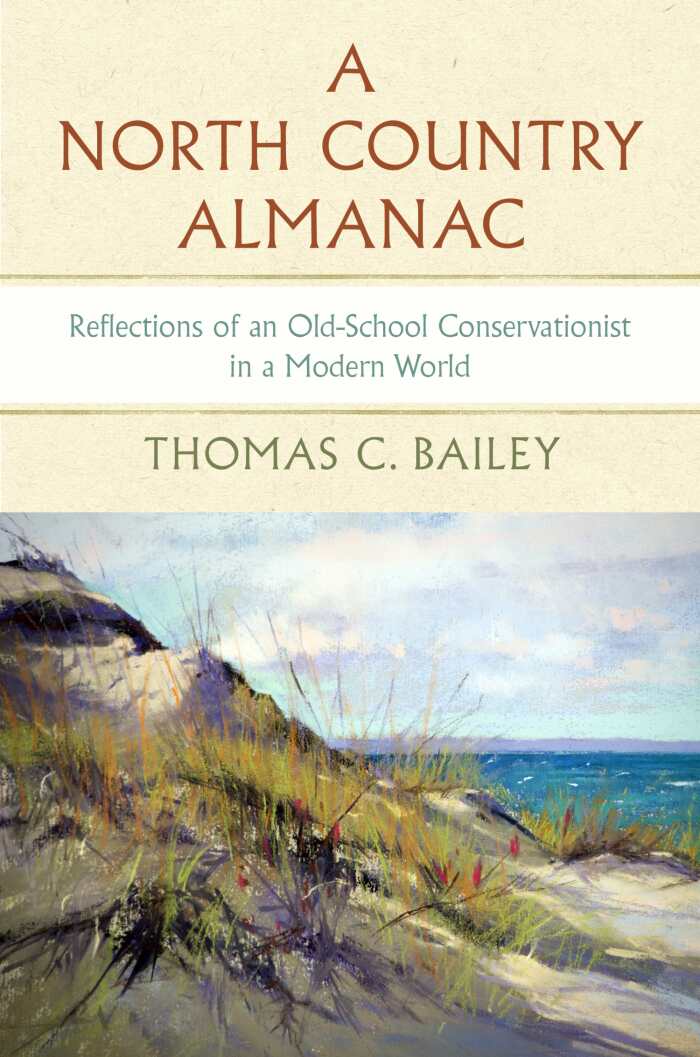
Thomas C. Bailey
Michigan State University Press
Hardcover $24.95 (126pp)
978-1-61186-286-7
Buy: Local Bookstore (Bookshop), Amazon
When people ask how he came to work in the field of conservation, Thomas C. Bailey has been known to respond that it was because, at the age of five, he saw a bald eagle. From then on, he was hooked. Growing up on the shores of Lake Superior with a father who was a wildlife biologist, Bailey has concern for the natural world in his blood.
While still in high school, he spoke before the US Senate Interior Committee in favor of declaring Michigan’s Isle Royale National Park a federal wilderness. He has since had a long career devoted to the care and preservation of the environment, most recently as the executive director of northern Michigan’s Little Traverse Conservancy, where he was known for his ability to bring together people of widely divergent political views to rally around issues they have in common.
“Some of our area’s most notorious environmentalists, as well as the most notorious developers, serve on our board of trustees,” he writes, calling the land conservancy movement a “ray of light” in a public policy landscape marked by contention and name-calling.
Bailey’s essays touch on topics as diverse as hunting; the effect of property taxes on land and land ownership; how taking a more sensitive, even shamanistic, approach to the land could counter current extractive and abusive practices; and how contact with nature is important to human health and well-being and is a shaper of our character and culture.
Bailey warns that the sacrifice of irreplaceable wild lands for short-term profit is both foolish and irresponsible; the private conservation movement, he writes, “has a key role to play in keeping nature close at hand to remind us all who we are and from whence we came.”
KRISTINE MORRIS (April 27, 2018)
The Right to Be Cold
One Woman’s Fight to Protect the Arctic and Save the Planet from Climate Change
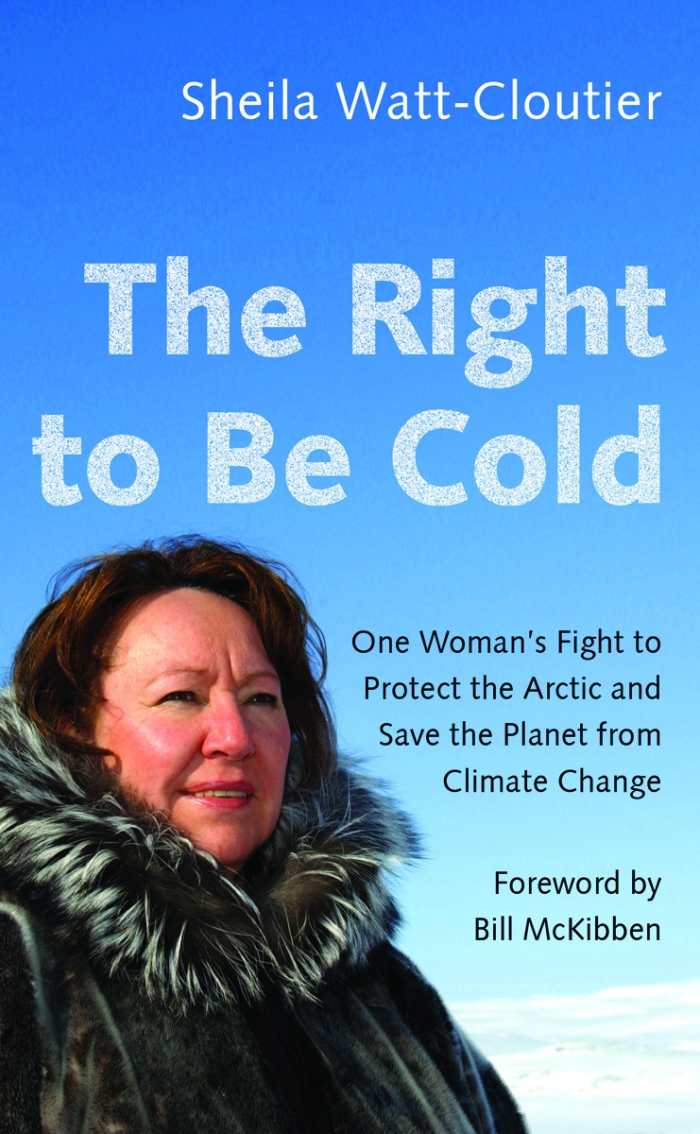
Sheila Watt-Cloutier
Bill McKibben, contributor
University of Minnesota Press
Softcover $22.95 (368pp)
978-1-5179-0497-5
Buy: Local Bookstore (Bookshop), Amazon
Sheila Watt-Cloutier grew up in the Arctic. As a native Inuk, she witnessed numerous environmental dangers, not the least of which was climate change. In a candid, heartfelt memoir that concentrates on her lifelong activism, Watt-Cloutier shares stories about her upbringing and her development into an adult whose passion is the protection of the indigenous Inuit.
Prior to her landmark work on climate change, Watt-Cloutier became president of the Inuit Circumpolar Council (ICC), an organization dedicated to protecting and promoting the Inuit culture and way of life. This led to her involvement in a campaign to rid the Arctic of a group of contaminants known as persistent organic pollutants, or POPs. The author writes authoritatively about this challenge, but it is her passion that really shines through the text; POPs are toxins that directly affected the Inuit food supply, so “the threat to our country food struck me at a deeply visceral, emotional level,” she notes. Her efforts, recounted in an engaging narrative, directly led to a major if imperfect multicountry agreement that helped to contain most but not all of the POPs.
An even graver challenge than POPs facing the Arctic, however, was climate change. Watt-Cloutier describes in somewhat disturbing detail how her homeland was affected: “Everyone in the Arctic communities could see that the ice melted sooner and returned later … but perhaps most shocking of all was that the very ground beneath our feet was no longer solid.” These dramatic visual images bring the harsh impact of climate change to life.
The Right to Be Cold takes its title from a journalist, who said to Watt-Cloutier during an interview, “You are fighting for the right to be cold.” This also became the slogan for an historic struggle that captured international attention. In documenting her fight, Sheila Watt-Cloutier is giving all of humanity a much-needed wake-up call.
BARRY SILVERSTEIN (April 27, 2018)
Bears Ears
Views from a Sacred Land
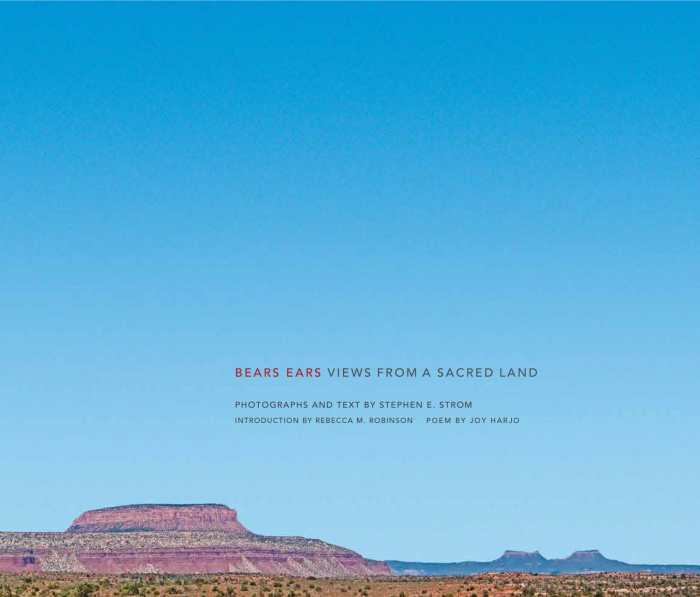
Stephen E. Strom
George F. Thompson Publishing
Hardcover $40.00 (240pp)
978-1-938086-56-4
Buy: Local Bookstore (Bookshop), Amazon
Bears Ears National Monument has been in the news of late as the Trump administration sought to dramatically scale back its protected acreage. Bears Ears: Views from a Sacred Land is a visual and literary introduction to this singular landscape, with a thorough textual tour of its social and geological history alongside Strom’s dazzling color photographs and a prayer-poem by Joy Harjo.
The monument derives its name from twin buttes that resemble two pointy ears poking out from the desert horizon. Strom’s panoramic, aerial, and other sharp photographs capture alluring and complex patterns in the rocky landscape in different seasons and lighting. From the subtle pastel striations in the sedimentary rock to dramatic sunset shadows and snow-tipped canyons and mountains, it’s a vibrant photographic portrait of a remote, almost otherworldly geography.
Capping the photographic survey is Strom’s lyrical essay about how this unique place exhibits many aspects of Earth’s formation and provides “a visible record of deep time.” The former research astronomer brilliantly decodes billions of eons in the development of the solar system and the terrestrial crust, oceans, atmosphere, and life forms, all of which are documented in various parts of Bears Ears.
Included are photographs of ancient pictographs, petroglyphs, and structures from the one hundred thousand archaeological and sacred sites studding Bears Ears. In President Obama’s 2016 national monument designation, he established the first collaborative land management system between the federal government and an intertribal coalition, whose Native American ancestors had inhabited these lands over two millennia. This precedent-setting move is controversial among Utah’s current crop of politicians and many Anglo-Mormon residents, though, and Bears Ears’ future is now in litigation. This book importantly documents what could be lost to us all in this magnificent but endangered region.
RACHEL JAGARESKI (February 27, 2018)
California Greenin’
How the Golden State Became an Environmental Leader
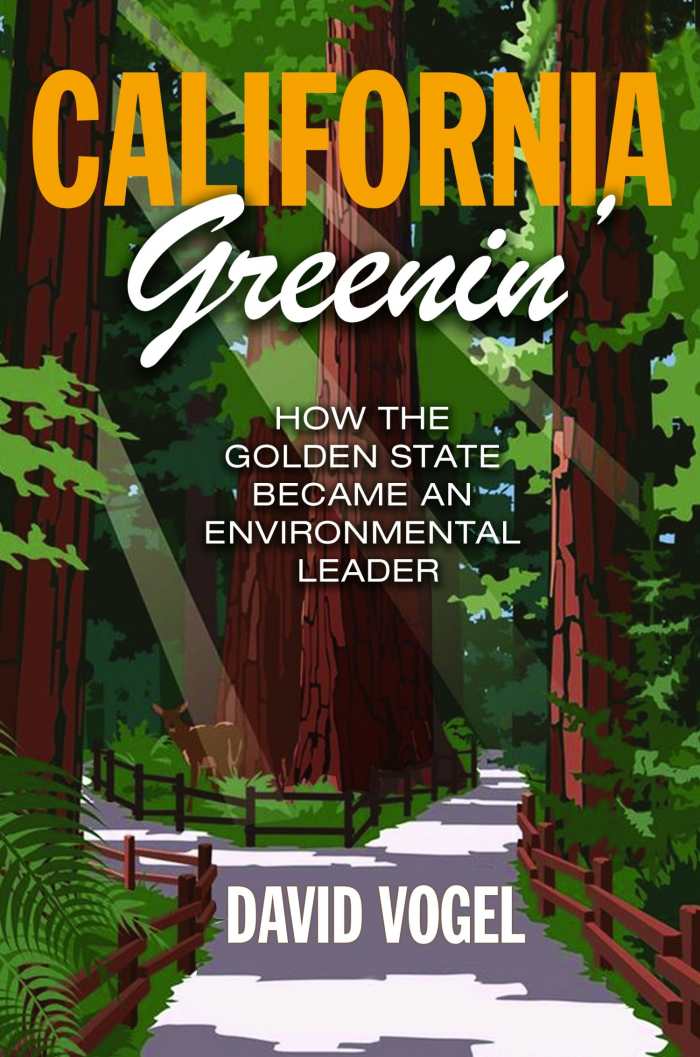
David Vogel
Princeton University Press
Hardcover $29.95 (304pp)
978-0-691-17955-1
Buy: Local Bookstore (Bookshop), Amazon
Retired university professor David Vogel does a masterful job of exploring past and present efforts to protect California’s natural beauty and resources. Through research and observation, Vogel confirms that “No other state has enacted so many innovative, comprehensive, and stringent environmental regulations over such a long period of time.” The “greening” of California, as Vogel calls it, derives from a unique collaboration of the state’s citizenry, businesses, and politically invoked regulations, all working toward a common goal.
The magnitude of environmental concern is clear in Vogel’s evocative descriptions of such fragile resources as California’s redwoods, beaches, coastline, and the San Francisco Bay. Sections of the book cover in detail the state’s challenges in dealing with the impact of oil drilling and air pollution, as well as the need to manage and preserve water.
Perhaps the most notable environmental protection policy is California’s vanguard automobile emissions standards that paved the way for establishment of federal standards. More recently, California has been an environmental leader in renewable energy and climate change initiatives, the latter of which “produced the strongest political backlash of any state environmental regulation,” writes Vogel.
The author superbly illustrates how California’s regulatory leadership in environmental policy has broader implications; he eloquently discusses geography and local politics, the role of businesses, and the limits of environmental regulation. With the current political landscape in mind, Vogel suggests that California’s approach “may well herald the future of American environmental regulation” in the sense that “a growing share of environmental policymaking in the United States will be done by states.” Equally significant is Vogel’s insightful closing section, in which he discusses the reality that California’s environmental policy has also created a competitive advantage for the state and contributed to its economic success.
California Greenin’ is a must-read for anyone seeking a path to locally driven environmental policymaking.
BARRY SILVERSTEIN (April 27, 2018)
With Distance in His Eyes
The Environmental Life and Legacy of Stewart Udall
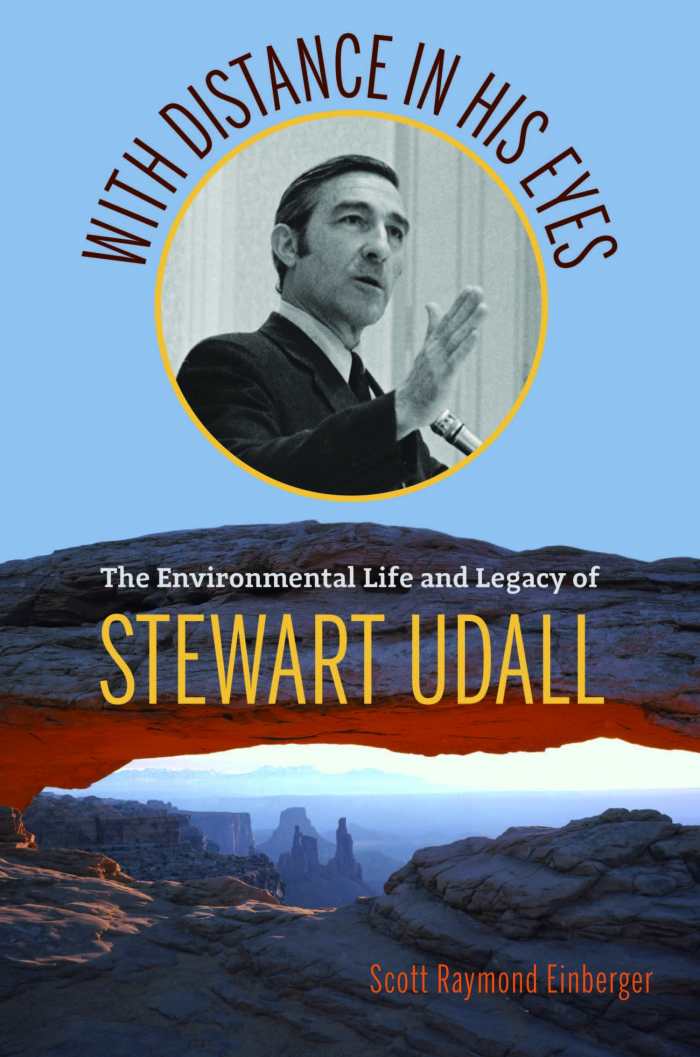
Scott Raymond Einberger
University of Nevada Press
Hardcover $34.95 (316pp)
978-1-943859-62-7
Buy: Local Bookstore (Bookshop), Amazon
This carefully researched, absorbing biography documents the remarkable environmental legacy of Stewart Udall.
The Washington DC headquarters of the Department of the Interior is named after Stewart Lee Udall. This excellent book by environmental historian Scott Einberger explains why. In eight years as Secretary of the Interior under Presidents Kennedy and Johnson, Udall’s accomplishments were legendary. He had a direct impact on natural resources conservation, environmental protection, land preservation, and the protection of endangered wildlife. During his tenure, he wrote The Quiet Crisis, an environmental history that became a bestseller. Udall was an activist against air and water pollution, and uttered the phrase “climate change” long before it gained notoriety.
The book is logically divided into three parts: Udall’s formative years, his body of work as US Secretary of the Interior, and his life after politics. Einberger traces Udall’s impressive career from his start as an Arizona congressman through his cabinet position to his post-political life as a private citizen who continued to publicly lead, speak, and write about environmental issues. Throughout, Udall’s environmental vision and innovation are highlighted.
One of the most insightful aspects of the book is Einberger’s assessment of why Udall was successful in his role as secretary. The author lists eight key reasons, including Udall’s conservation trips, his outstanding staff, his writing expertise, and his ability to compromise. Einberger notes that Udall was a “major contributor” to the passing of at least four key environmental acts, including the Wilderness Act and the Endangered Species Preservation Act. Lesser known, perhaps, and well documented by Einberger, is the fact that Udall continued his fight for environmental quality long after he departed the nation’s capital.
Einberger offers extensive notes validating the material in each chapter. He also draws several perceptive conclusions about Udall’s lifework, not the least of which is that he served “as a model for ‘working together’ and bipartisanship.” This is a relevant biographical study of a significant American environmentalist.
BARRY SILVERSTEIN (April 27, 2018)
Brave New Arctic
The Untold Story of the Melting North
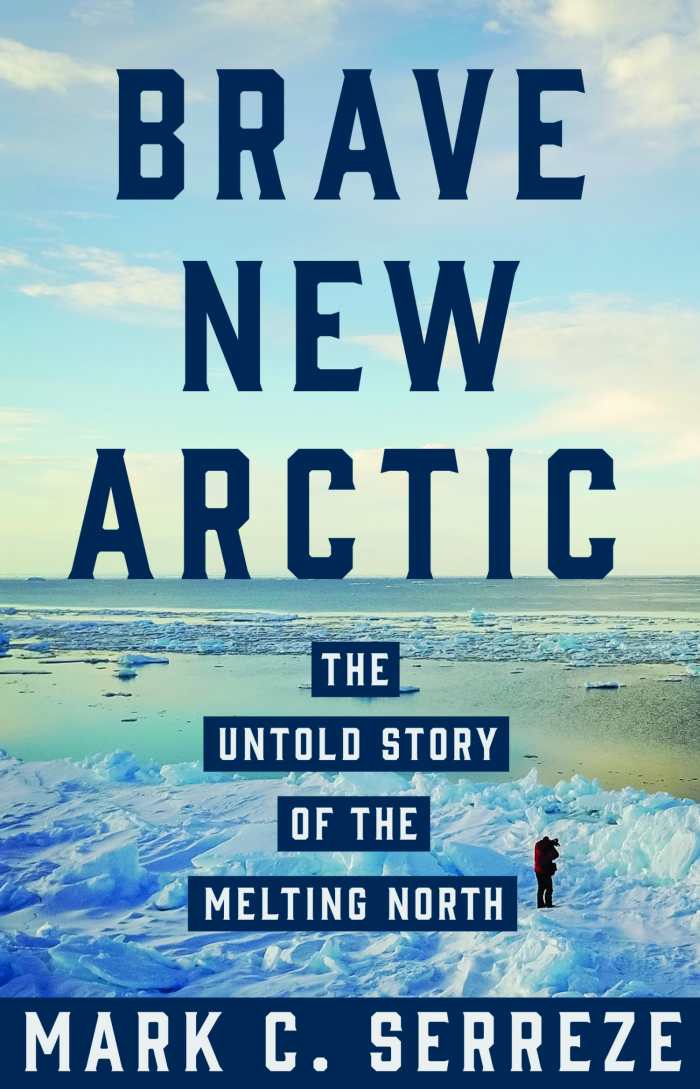
Mark C. Serreze
Princeton University Press
Hardcover $24.95 (248pp)
978-0-691-17399-3
Buy: Local Bookstore (Bookshop), Amazon
Geographer Mark C. Serreze admits that it took him a while to fully understand how human actions cause drastic environmental changes in the Arctic. However, when mounting evidence helped him reach his “epiphany,” he shifted gears quickly, becoming an ardent advocate for the endangered polar region. His book sounds a clarion call about the global consequences of a melting north.
Serreze started his scientific career as a graduate student measuring ice caps in the Canadian Arctic. His narrative follows his path to becoming an expert on sea ice and Arctic physical geography. Concurrently, he summarizes scientific advances in data collection, computerization, and climate modeling that enabled scientists to tease out human influence from natural variability in the warming global climate.
Though full of acronyms and complex concepts, Serreze’s text is clear, accessible to a popular audience and accompanied with numerous illustrations. Weather wonks and fans of polar adventure will be especially riveted as Serreze describes “Arctic amplification”—the various environmental feedback loops that enhance rising air and water temperatures, a melting cryosphere, and altered sea and wind circulation. He patiently builds the case for action to reverse these patterns, which cause extreme weather and rising sea levels elsewhere, too.
At times the book has the feeling of a suspenseful detective novel, with dedicated scientist protagonists trying to beat the clock against impending environmental disaster, all the while battling self-interested political and corporate actors who lust after “resources” that can more easily be extracted from an ice-free zone and who threaten important research work with lawsuits and funding cuts. At other times, there is a melancholy tone as the author elegizes with past observations of a frozen landscape that will never be the same again.
Brave New Arctic paints a chilling scenario for a rapidly warming polar region if scientists and government leaders cannot find a way to work together—and soon—to reverse the worst aspects of climate change.
RACHEL JAGARESKI (February 27, 2018)
Kara Hansen
